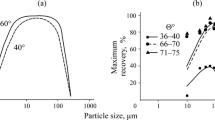Abstract
Physical relationships in the flotation process have been analyzed by modeling a flotation complex consisting of one bubble and one particle. The influence of inertial force on stability have been evaluated, with various bubble dimensions and various values of the surface tension at the liquid-gas boundary.
Similar content being viewed by others
References
N. S. Belova and S. B. Leonov, “Influence of physicochemical properties of polar reagents on the activity of liquid—gas interface in the flotation process,”Fiz.-Tekh. Probl. Razrab. Polezn. Iskop., No. 6 (1995).
V. I. Melik-Gaikazyan, “Interfacial interactions,” in:Physicochemical Foundations of Flotation Theory [in Russian], Nauka, Moscow (1983).
A. F. Taggart and A. M. Goudin, “Surface tension and adsorption phenomena in flotation,”Trans. AIME, 68, (1923).
Additional information
State Technical University, Irkutsk, Translated from Fiziko-Tekhnicheskie Problemy Razrabotki Poleznykh Iskopaemykh, No. 1, pp. 92–95, January–February, 1999.
Rights and permissions
About this article
Cite this article
Belova, N.S., Leonov, S.B. Theoretical aspects of modeling the elementary act of flotation. J Min Sci 35, 91–95 (1999). https://doi.org/10.1007/BF02562451
Received:
Issue Date:
DOI: https://doi.org/10.1007/BF02562451




